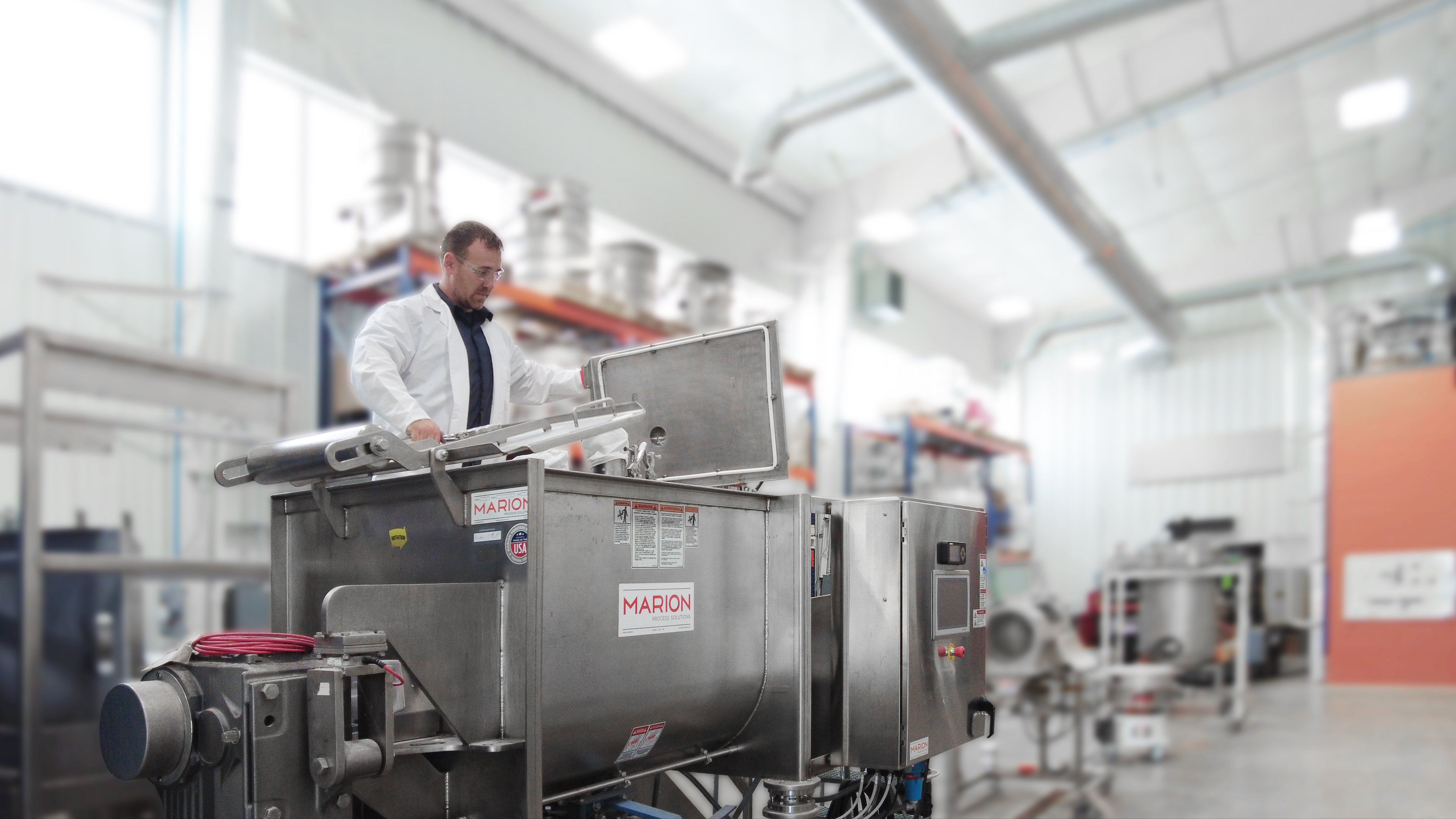
When it comes to choosing a mixer, things like trough size and agitator design tend to be the features people think about first. While these are important features to consider, mixer covers should also be top of mind.
“Covers are extremely important,” Bill Noonan, Senior Application Engineer at Marion Process Solutions, says.
“Not having the right mixer cover can increase the risk of accidents and injuries and potentially expose your product to contamination. That’s why we spend a lot of time on the phone with our customers talking about the right cover for their mixers.”
With this in mind, here are five main characteristics you should look for when considering the right cover design for your mixer:
1. Counter balancing for improved ergonomics, accident and injury prevention.
Given that ergonomic injuries account for 33% of all U.S. worker injuries and illness cases, any design feature that can help reduce fatigue and injury can spare you a lot of headaches. Some covers can weigh 50 pounds or more, so a good way to lighten the load for operators is to look for hinged covers that are counter balanced or counter weighted, as well as those that are cylinder actuated.
Counter balanced covers make it easier for operators to open and close repeatedly throughout their shift. Because they are designed to open and close smoothly and gradually, it is virtually impossible for a cover to unexpectedly slam shut on a finger or cause other serious injuries that would result in lost labor, production time or product.
“All of a sudden, investing in a counter balanced cover becomes a no-brainer, especially when you consider how it pays for itself by eliminating these types of safety risks.” Noonan says.
2. Solid (not hollow) counterweights to minimize contamination risks and costly product recalls.
Some manufacturers may market their mixers with “lightweight” covers, but you should ask for further details on their construction. Some covers may feature hollow counterweights, which can actually compromise the efficiency and safety of your operation.
“We never use hollow tubes,” Noonan says. “There are too many risks. That’s why we only use solid tubes.
Covers with counterweights require precise balancing adjustments. Competitors may use hollow pipe/tube, which are usually calibrated using lead shot. Because of this, they are more susceptible to cracking than solid covers, there’s a higher risk of lead and bacteria finding its way into your product. According to the Grocery Manufacturers Association (GMA) and Food Marketing Institute (FMI), one recall can cost a food company an average $10 million in direct costs. This does not include lost revenue from a production shutdown or damage to your brand’s credibility.
Solid counterweights, on the other hand, eliminate these risks entirely.
3. Full-width access for easy, frequent and thorough cleaning
When covers are an obstacle in the cleaning process of your mixer, the risk of product contamination rises dramatically.
Mixers that are not properly cleaned can build up residue and encourage flavor, allergen and bacteria to transfer between batches. If not caught early, legal complaints, product recalls and costly fines are sure to follow.
To prevent these issues from arising, you should look for covers that make it easy to clean the surface areas inside your mixer.
Covers with the widest unrestricted or unobstructed access can help your staff adhere to strict sanitation requirements and ensure your product is consistently mixed to specifications with every batch.
“Since you don’t have to struggle with a cover that gets in your way, you can easily clean your mixer—and in less time,” Noonan says.
4. Strong, long-lasting seals to eliminate dusting, contamination and unnecessary maintenance.
“Covers with a tight seal help keep your ingredients safe inside your mixer while protecting your batch from the things you don’t want inside,” Noonan says.
To prevent product loss, minimize waste and avoid clean-up costs, a strong seal between a cover and mixer is necessary.
Gaskets are used to prevent unwanted materials from entering the mixer. They also keep valuable ingredients or harmful dust from leaking out and causing an environmental hazard.
But not all seals provide a leak-free barrier. In fact, tape gaskets commonly used on mixers are prone to wear and tear and need to be closely monitored and replaced frequently.
Removing and replacing tape gaskets can be hassle both in terms of time and safety risks. Removing them requires sharp tools or a scraper and an adhesive remover which can be harmful if it is inhaled or comes in contact with skin.
O-ring gaskets provide a more effective seal than tape gaskets and can be replaced quickly and easily without the hassle. In addition to being better at keeping moisture from getting inside your product and dust from accumulating outside the mixer, they are easy-to-clean and offer a longer service life due to their design. If you are working with dusty materials or allergens, you know the importance of cleaning between mix campaigns.
See for yourself: watch this video for a demonstration comparing the o-ring and tape gasket replacement process.
5. Covers that can be customized to your specific application needs.
Whether your mixing application requires extreme temperatures, vacuum pressure, sealing efficiency, accessibility issues or component integration, customizing the right cover can be as simple as adding doors and dust collection vents or as complex as attaching pressure relief ports and threaded temperature probes.
“Because every application—and every mixer—is unique, there isn’t a one-size-fits-all approach to cover design.” Bill Noonan says.
That’s why it’s a good idea to work with a manufacturer who has expertise in mixer customization who can evaluate your application and make a recommendation that not only keeps your product and staff secure but adds efficiency and cost-savings to your process.

What else should you consider when designing a mixer?
Check out these resources to learn more:
Three Considerations for Selecting Horizontal Mixing Equipment
Choosing the Right Agitator for Your Application
Top 3 Considerations in Choosing a Mixer for Food Processing Solutions